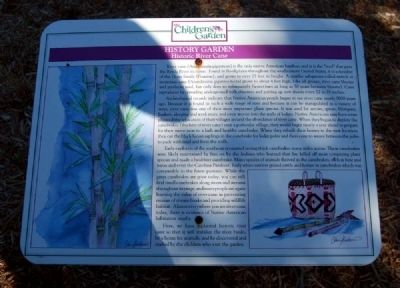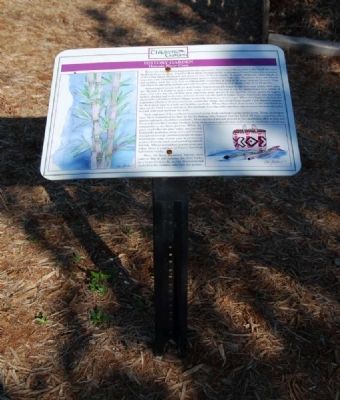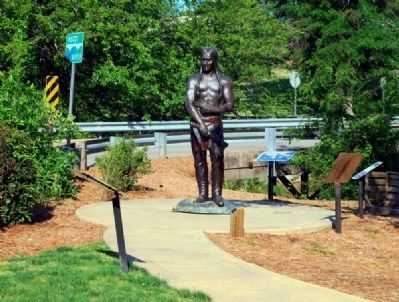Greenville in Greenville County, South Carolina — The American South (South Atlantic)
Historic River Cane
The Children's Garden
— History Garden —
River cane (Arundinaria gigantean) is the only native American bamboo, and it is the "reed" that gave the Reedy River its name. Found in flood plains throughout the southeastern United States, it is a member of the Grass family (Poaceae), and grows to over 25 feet in height. A smaller subspecies called switch or mountain cane (Arundinaria gigantea tecta grows to about 4 feet high. Like all grasses, river cane blooms and produces seeds, but only does so infrequently (sometimes as long as 50 years between blooms). Cane reproduces by spreading underground with rhizomes and putting up new shoots every 12 to 18 inches.
Archaeological records indicate that Native American people began to use river cane nearly 9000 years ago. Because it is found in such a wide range of sizes and because it can be manipulated in a variety of ways, river cane was one of their most important plant species. It was used for arrows, spears, blowguns, baskets, sleeping and work mats, and even woven into the walls of lodges. Native Americans may have even planned the relocation of their villages around the abundance of river cane. When they began to deplete the canebrakes (thickets of river cane) near a particular village, they would begin nearly a year ahead to prepare for their new move to a lush and healthy canebreak. When they rebuilt their homes in the new location, they cut the black locust saplings in the canebreak for lodge poles and then cane to weave between the poles to pack with mud and form the walls.
Early explorers of the southeast recounted seeing thick canebreaks many miles across. These canebreaks were likely maintained by fires set by the Indians who learned that fire killed off most competing plant species and made a healthier canebreak. Many species of animals thrived in the canebreak, such as bear and bison and even the Carolina Parakeet. Early white settlers grazes cattle and horses in canebreaks which was comparable to the finest pastures. While the great canebreaks are gone today, you can still find small canebreaks along rivers and streams throughout its range, and many people are again learning the value of river cane in preventing erosion of stream banks and providing wildlife habitat. Almost everywhere you see river cane today, there is evidence of Native American habitation nearby.
Here, we have replanted historic river cane so that it will stabilize the river banks, be a home for animals, and be discovered and studied by the children who visit the garden.
Erected by City of Greenville Parks and Recreation.
Topics. This historical marker is listed in these topic lists: Horticulture & Forestry • Native Americans • Natural Resources.
Location. 34° 50.95′ N, 82° 24.25′ W. Marker is in Greenville, South Carolina, in Greenville County. Marker is on Reedy View Drive. Marker is located on the grounds of the Children's Garden at Linky Stone Park. Touch for map. Marker is at or near this postal address: 24 Reedy View Drive, Greenville SC 29601, United States of America. Touch for directions.
Other nearby markers. At least 10 other markers are within walking distance of this marker. Historic Plants Garden (here, next to this marker); History of the Reedy River (here, next to this marker); Linky Stone Park (here, next to this marker); The Geologic History of Greenville (within shouting distance of this marker); Huguenot Mill Office (about 700 feet away, measured in a direct line); Carolina Supply Company (approx. 0.2 miles away); Downtown Baptist Church (approx. 0.2 miles away); Prospect Hill Park (approx. 0.2 miles away); Greenville County Courthouse / The Willie Earle Lynching Trial (approx. 0.2 miles away); Buck Mickel (approx. 0.2 miles away). Touch for a list and map of all markers in Greenville.
Also see . . .
1. River Cane. Bloodroot and black walnut hulls were used to dye splits of the river cane basket that is displayed at the
Chattooga Conservancy office. (Submitted on May 28, 2010, by Brian Scott of Anderson, South Carolina.)
2. Carolina Parakeet. The Carolina Parakeet (Conuropsis carolinensis) was the only parrot species native to the eastern United States. (Submitted on May 28, 2010, by Brian Scott of Anderson, South Carolina.)
Credits. This page was last revised on June 16, 2016. It was originally submitted on May 28, 2010, by Brian Scott of Anderson, South Carolina. This page has been viewed 1,642 times since then and 34 times this year. Photos: 1, 2, 3. submitted on May 28, 2010, by Brian Scott of Anderson, South Carolina.


